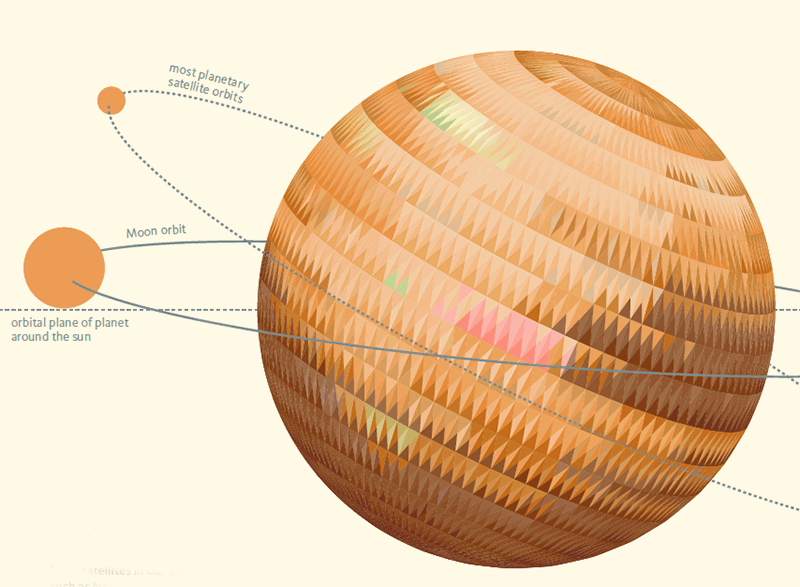The Moon’s Unique Orbit
(Article Credit AnswersInGenesis.org)
The moon has another unique feature that is often overlooked but just as important—its orbit around the sun. To appreciate its specialness requires some explanation.
Generally speaking, smaller satellites move in an elliptical orbit around their planets, a sort of stretched-out circle. However, all the major satellites, including the moon, have nearly circular orbits around their planets. As each satellite orbits the planet, it is also rotating around its own axis. Most satellites, including our moon, orbit their planets in the same direction that the planets rotate on their axes (with one exception among the major satellites, Neptune’s Triton).
Here’s what is interesting. Most major satellites orbit on a plane that matches the planet’s rotation along its equator. (Again, Triton is an exception.) Many minor satellites orbit this way too, though some have extreme elliptical orbits with odd paths around their planet—some like Triton even revolve backward with respect to their planet’s rotation. The moon doesn’t fit any of these categories.
However, the moon orbits on a plane that nearly matches the plane of the earth’s revolution around the sun (see illustration below). No other satellite orbits in the same plane that its planet revolves around the sun. Not one out of 175.

Most satellites in our solar system, such as Neptune’s Triton and Jupiter’s Ganymede, orbit on a plane that matches their planet’s rotation along its equator. The moon isn’t like this. It orbits in nearly the same plane that the earth revolves around the sun.
That’s very different from the earth’s rotation. This would be impossible if the moon evolved from the same spinning cloud as the earth. So secular astronomers assume an outside body struck the earth at a sharp angle, and the moon formed from the debris of this collision.
The Bible explains, in contrast, that the Creator placed the moon in this orbit for a special purpose. It serves a lifegiving role in maintaining the earth’s tilt, which provides seasons and keeps temperatures balanced. No other planet has a moon like this.
This fact has a profound effect on the earth, suggesting design. The earth needs to maintain its tilt in order to have the changing seasons and keep temperatures fairly balanced around the globe. But other bodies in the solar system exert a small gravitational pull that slowly tends to tweak the earth’s axial tilt. Left unchecked, the earth’s tilt would gradually change.
At one extreme, this change in the earth’s tilt would result in no seasons. On the other extreme, seasonal changes would be much more drastic than they are today, with much of the earth shifting from the boiling tropics in one season to the Antarctic’s frigid, sunless winters. Obviously, this would have disastrous consequences for living things.
But this does not happen because of the moon’s unique large size compared to earth and its unique orbit in the same plane that the earth orbits the sun. These two factors combine to allow the moon to stabilize the earth’s tilt to within two degrees. Both factors must be in play for this stabilizing force to work. This is the only planet where this is possible, and since life appears unique to earth, this is the only planet where it matters.
FineTunedUniverse.com
The moon is exactly the correct size and distance from the sun to make a solar eclipse possible
Solar eclipse
As seen from the Earth, a solar eclipse is a type of eclipse that occurs when the Moon passes between the Sun and Earth, and the Moon fully or partially blocks the Sun. This can happen only at new moon when the Sun and the Moon are in conjunction as seen from Earth in an alignment referred to as syzygy. In a total eclipse, the disk of the Sun is fully obscured by the Moon. In partial and annular eclipses, only part of the Sun is obscured.
The Uniqueness of the Moon
The moon has a number of distinctive characteristics. It is both 400 times smaller and 400 times closer to Earth than the sun is. This means that the moon and sun have about the same apparent size in our sky on average.
This makes total solar eclipses possible. Earth is the only known planet that can experience eclipses where its moon so precisely covers the sun.
This has made possible the discovery of the solar chromosphere. The chromosphere can only be seen by eye during a total solar eclipse.
The moon is exactly the correct size and distance from the sun to make a solar eclipse possible.
This didn't happen by accident over millions of years.
This was a precise design by God.
Precise design can be seen all around us.
Psalm 19:1-3 King James Version (KJV)
1 The heavens declare the glory of God; and the firmament sheweth his handywork.
2 Day unto day uttereth speech, and night unto night sheweth knowledge.
3 There is no speech nor language, where their voice is not heard.
FineTunedUniverse.com
